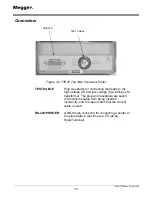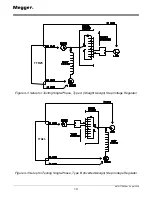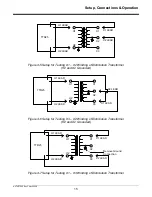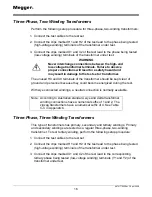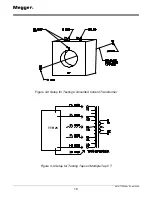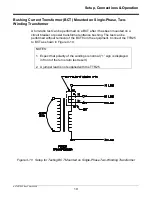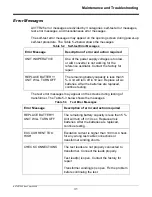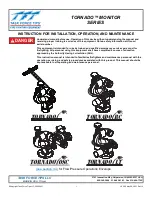
Setup, Connections & Operation
AVTMTTR25 Rev C April 2008
17
F
WARNING
Never interchange connections between the high- and
low-voltage transformer terminals. Failure to observe
proper connections will result in a safety hazard and
may result in damage to the test set or transformer.
With wye connected windings, a neutral connection is normally available.
Current Transformers (CTs)
Connections to CTs are made backwards compared to power, distribution or
potential transformers. The H terminals on the test lead set must be connected to
the X terminals on the CT; and the X terminals on the test lead set must be
connected to the H terminals on the CT.
NOTE:
Dots on the housing of the transformer are commonly used to
identify terminals of the same polarity.
F
WARNING
Failure to observe proper connections will result in a safety hazard and
may result in damage to the test set or CT. Failure to observe voltage
rating of low-current X winding may result in damage to the CT.
NOTES:
1.
The TTR25 may supply up to 100 mA of excitation current. The TTR25
will automatically select the appropriate test voltage (8 V, 1.5 V, or 0.5
V) when testing CTs. Some current transformers with turn ratio of 50:5
and less may require more than 100 mA of excitation current when
excited from 0.5 V source. These CTs can not be tested with the TTR25.
2.
Expect that polarity of the windings is normal (“+” sign is displayed in
front of the turns ratio test result).
Unmounted CTs
NOTE: The illustrated connection diagrams are provided as connection guides
and do not suggest the physical location of the bushings / terminals of the device
being tested.
Figure 4-8 shows the setup for testing unmounted current transformers.
Figure 4-9 shows the setup for testing the taps on a multiple-tap CT.








